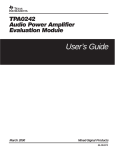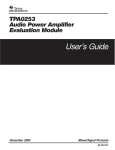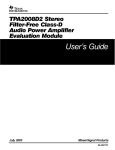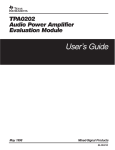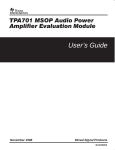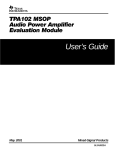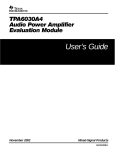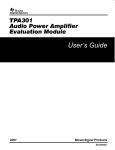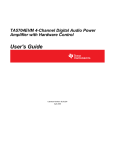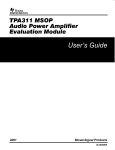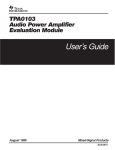Download Texas Instruments SLOU121 User's Manual
Transcript
User’s Guide February 2002 Mixed Signal Products SLOU121 IMPORTANT NOTICE Texas Instruments Incorporated and its subsidiaries (TI) reserve the right to make corrections, modifications, enhancements, improvements, and other changes to its products and services at any time and to discontinue any product or service without notice. Customers should obtain the latest relevant information before placing orders and should verify that such information is current and complete. All products are sold subject to TI’s terms and conditions of sale supplied at the time of order acknowledgment. TI warrants performance of its hardware products to the specifications applicable at the time of sale in accordance with TI’s standard warranty. Testing and other quality control techniques are used to the extent TI deems necessary to support this warranty. Except where mandated by government requirements, testing of all parameters of each product is not necessarily performed. TI assumes no liability for applications assistance or customer product design. Customers are responsible for their products and applications using TI components. To minimize the risks associated with customer products and applications, customers should provide adequate design and operating safeguards. TI does not warrant or represent that any license, either express or implied, is granted under any TI patent right, copyright, mask work right, or other TI intellectual property right relating to any combination, machine, or process in which TI products or services are used. Information published by TI regarding third–party products or services does not constitute a license from TI to use such products or services or a warranty or endorsement thereof. Use of such information may require a license from a third party under the patents or other intellectual property of the third party, or a license from TI under the patents or other intellectual property of TI. Reproduction of information in TI data books or data sheets is permissible only if reproduction is without alteration and is accompanied by all associated warranties, conditions, limitations, and notices. Reproduction of this information with alteration is an unfair and deceptive business practice. TI is not responsible or liable for such altered documentation. Resale of TI products or services with statements different from or beyond the parameters stated by TI for that product or service voids all express and any implied warranties for the associated TI product or service and is an unfair and deceptive business practice. TI is not responsible or liable for any such statements. Mailing Address: Texas Instruments Post Office Box 655303 Dallas, Texas 75265 Copyright 2002, Texas Instruments Incorporated EVM IMPORTANT NOTICE Texas Instruments (TI) provides the enclosed product(s) under the following conditions: This evaluation kit being sold by TI is intended for use for ENGINEERING DEVELOPMENT OR EVALUATION PURPOSES ONLY and is not considered by TI to be fit for commercial use. As such, the goods being provided may not be complete in terms of required design-, marketing-, and/or manufacturing-related protective considerations, including product safety measures typically found in the end product incorporating the goods. As a prototype, this product does not fall within the scope of the European Union directive on electromagnetic compatibility and therefore may not meet the technical requirements of the directive. Should this evaluation kit not meet the specifications indicated in the EVM User’s Guide, the kit may be returned within 30 days from the date of delivery for a full refund. THE FOREGOING WARRANTY IS THE EXCLUSIVE WARRANTY MADE BY SELLER TO BUYER AND IS IN LIEU OF ALL OTHER WARRANTIES, EXPRESSED, IMPLIED, OR STATUTORY, INCLUDING ANY WARRANTY OF MERCHANTABILITY OR FITNESS FOR ANY PARTICULAR PURPOSE. The user assumes all responsibility and liability for proper and safe handling of the goods. Further, the user indemnifies TI from all claims arising from the handling or use of the goods. Please be aware that the products received may not be regulatory compliant or agency certified (FCC, UL, CE, etc.). Due to the open construction of the product, it is the user’s responsibility to take any and all appropriate precautions with regard to electrostatic discharge. EXCEPT TO THE EXTENT OF THE INDEMNITY SET FORTH ABOVE, NEITHER PARTY SHALL BE LIABLE TO THE OTHER FOR ANY INDIRECT, SPECIAL, INCIDENTAL, OR CONSEQUENTIAL DAMAGES. TI currently deals with a variety of customers for products, and therefore our arrangement with the user is not exclusive. TI assumes no liability for applications assistance, customer product design, software performance, or infringement of patents or services described herein. Please read the EVM User’s Guide and, specifically, the EVM Warnings and Restrictions notice in the EVM User’s Guide prior to handling the product. This notice contains important safety information about temperatures and voltages. For further safety concerns, please contact the TI application engineer. Persons handling the product must have electronics training and observe good laboratory practice standards. No license is granted under any patent right or other intellectual property right of TI covering or relating to any machine, process, or combination in which such TI products or services might be or are used. Mailing Address: Texas Instruments Post Office Box 655303 Dallas, Texas 75265 Copyright 2002, Texas Instruments Incorporated EVM WARNINGS AND RESTRICTIONS It is important to operate this EVM within the specified input and output ranges described in the EVM User’s Guide. Exceeding the specified input range may cause unexpected operation and/or irreversible damage to the EVM. If there are questions concerning the input range, please contact a TI field representative prior to connecting the input power. Applying loads outside of the specified output range may result in unintended operation and/or possible permanent damage to the EVM. Please consult the EVM User’s Guide prior to connecting any load to the EVM output. If there is uncertainty as to the load specification, please contact a TI field representative. During normal operation, some circuit components may have case temperatures greater than 60°C. The EVM is designed to operate properly with certain components above 60°C as long as the input and output ranges are maintained. These components include but are not limited to linear regulators, switching transistors, pass transistors, and current sense resistors. These types of devices can be identified using the EVM schematic located in the EVM User’s Guide. When placing measurement probes near these devices during operation, please be aware that these devices may be very warm to the touch. Mailing Address: Texas Instruments Post Office Box 655303 Dallas, Texas 75265 Copyright 2002, Texas Instruments Incorporated Information About Cautions and Warnings Preface Read This First How to Use This Manual This document contains the following chapters: - Chapter 1—Introduction - Chapter 2—Quick Start - Chapter 3—Details - Chapter 4—Reference Information About Cautions and Warnings This book may contain cautions and warnings. This is an example of a caution statement. A caution statement describes a situation that could potentially damage your software or equipment. This is an example of a warning statement. A warning statement describes a situation that could potentially cause harm to you. The information in a caution or a warning is provided for your protection. Please read each caution and warning carefully. v Related Documentation From Texas Instruments Related Documentation From Texas Instruments - TI Plug-N-Play Audio Amplifier Evaluation Platform (literature number SLOU011) provides detailed information on the evaluation platform and its use with TI audio evaluation modules - TPA6011A4 Stereo 2-W Audio Power Amplifier (literature number SLOS392) This is the data sheet for the TPA6011A4 audio amplifier integrated circuit. FCC Warning This equipment is intended for use in a laboratory test environment only. It generates, uses, and can radiate radio frequency energy and has not been tested for compliance with the limits of computing devices pursuant to subpart J of part 15 of FCC rules, which are designed to provide reasonable protection against radio frequency interference. Operation of this equipment in other environments may cause interference with radio communications, in which case the user at his own expense will be required to take whatever measures may be required to correct this interference. vi Contents Contents 1 Introduction . . . . . . . . . . . . . . . . . . . . . . . . . . . . . . . . . . . . . . . . . . . . . . . . . . . . . . . . . . . . . . . . . . . . . 1.1 Feature Highlights . . . . . . . . . . . . . . . . . . . . . . . . . . . . . . . . . . . . . . . . . . . . . . . . . . . . . . . . . . 1.2 Description . . . . . . . . . . . . . . . . . . . . . . . . . . . . . . . . . . . . . . . . . . . . . . . . . . . . . . . . . . . . . . . . 1.3 TPA6011A4 EVM Specifications . . . . . . . . . . . . . . . . . . . . . . . . . . . . . . . . . . . . . . . . . . . . . . 1-1 1-2 1-3 1-3 2 Quick Start . . . . . . . . . . . . . . . . . . . . . . . . . . . . . . . . . . . . . . . . . . . . . . . . . . . . . . . . . . . . . . . . . . . . . . 2.1 Precautions . . . . . . . . . . . . . . . . . . . . . . . . . . . . . . . . . . . . . . . . . . . . . . . . . . . . . . . . . . . . . . . . 2.2 Quick Start List for Platform . . . . . . . . . . . . . . . . . . . . . . . . . . . . . . . . . . . . . . . . . . . . . . . . . . 2.3 Quick Start List for Stand-Alone . . . . . . . . . . . . . . . . . . . . . . . . . . . . . . . . . . . . . . . . . . . . . . 2-1 2-2 2-3 2-5 3 Details . . . . . . . . . . . . . . . . . . . . . . . . . . . . . . . . . . . . . . . . . . . . . . . . . . . . . . . . . . . . . . . . . . . . . . . . . . 3-1 3.1 Precautions . . . . . . . . . . . . . . . . . . . . . . . . . . . . . . . . . . . . . . . . . . . . . . . . . . . . . . . . . . . . . . . . 3-2 3.2 The TPA6011A4 Audio Power Amplifier Evaluation Module . . . . . . . . . . . . . . . . . . . . . . . 3-3 3.2.1 TPA6011A4 Audio Amplifier IC . . . . . . . . . . . . . . . . . . . . . . . . . . . . . . . . . . . . . . . . 3-4 3.2.2 Inputs and Gain . . . . . . . . . . . . . . . . . . . . . . . . . . . . . . . . . . . . . . . . . . . . . . . . . . . . . 3-5 3.2.3 Volume Control . . . . . . . . . . . . . . . . . . . . . . . . . . . . . . . . . . . . . . . . . . . . . . . . . . . . . . 3-5 3.2.4 Differential Input . . . . . . . . . . . . . . . . . . . . . . . . . . . . . . . . . . . . . . . . . . . . . . . . . . . . . 3-8 3.2.5 Depop Circuitry . . . . . . . . . . . . . . . . . . . . . . . . . . . . . . . . . . . . . . . . . . . . . . . . . . . . . 3-9 3.2.6 BTL Operation . . . . . . . . . . . . . . . . . . . . . . . . . . . . . . . . . . . . . . . . . . . . . . . . . . . . . . 3-9 3.2.7 Single-Ended Operation . . . . . . . . . . . . . . . . . . . . . . . . . . . . . . . . . . . . . . . . . . . . . . 3-9 3.3 Using the TPA6011A4 EVM With the Plug-N-Play Evaluation Platform . . . . . . . . . . . . 3-10 3.3.1 Installing and Removing EVM Boards . . . . . . . . . . . . . . . . . . . . . . . . . . . . . . . . . 3-10 3.3.2 TPA6011A4 Module Jumper Settings and Switches . . . . . . . . . . . . . . . . . . . . . 3-10 3.3.3 Signal Routing . . . . . . . . . . . . . . . . . . . . . . . . . . . . . . . . . . . . . . . . . . . . . . . . . . . . . 3-12 3.3.4 Mute (Shutdown)/Mode . . . . . . . . . . . . . . . . . . . . . . . . . . . . . . . . . . . . . . . . . . . . . 3-13 3.3.5 Power Requirements . . . . . . . . . . . . . . . . . . . . . . . . . . . . . . . . . . . . . . . . . . . . . . . . 3-15 3.3.6 Inputs and Outputs . . . . . . . . . . . . . . . . . . . . . . . . . . . . . . . . . . . . . . . . . . . . . . . . . 3-16 3.4 Using the TPA6011A4 EVM Stand-Alone . . . . . . . . . . . . . . . . . . . . . . . . . . . . . . . . . . . . . 3-17 3.4.1 TPA6011A4 EVM Connected for BTL Output . . . . . . . . . . . . . . . . . . . . . . . . . . . 3-17 3.4.2 TPA6011A4 EVM Connected for Single-Ended Output . . . . . . . . . . . . . . . . . . . 3-18 4 Reference . . . . . . . . . . . . . . . . . . . . . . . . . . . . . . . . . . . . . . . . . . . . . . . . . . . . . . . . . . . . . . . . . . . . . . . 4-1 4.1 TPA6011A4 EVM Layers and Board Schematic . . . . . . . . . . . . . . . . . . . . . . . . . . . . . . . . . 4-2 4.2 TPA6011A4 EVM Parts List . . . . . . . . . . . . . . . . . . . . . . . . . . . . . . . . . . . . . . . . . . . . . . . . . . 4-4 vii Contents Figures 1–1 2–1 2–2 2–3 3–1 3–2 3–3 3–4 3–5 3–6 3–7 3–8 3–9 3–10 3–11 4–1 4–2 4–3 The TI TPA6011A4 Audio Amplifier Evaluation Module . . . . . . . . . . . . . . . . . . . . . . . . . . . . . 1-3 Quick Start Platform Map . . . . . . . . . . . . . . . . . . . . . . . . . . . . . . . . . . . . . . . . . . . . . . . . . . . . . . 2-2 Module Preparation . . . . . . . . . . . . . . . . . . . . . . . . . . . . . . . . . . . . . . . . . . . . . . . . . . . . . . . . . . . 2-4 Quick Start Module Map . . . . . . . . . . . . . . . . . . . . . . . . . . . . . . . . . . . . . . . . . . . . . . . . . . . . . . . 2-5 The TI Plug-N-Play Audio Amplifier Evaluation Platform . . . . . . . . . . . . . . . . . . . . . . . . . . . . 3-2 TPA6011A4 EVM . . . . . . . . . . . . . . . . . . . . . . . . . . . . . . . . . . . . . . . . . . . . . . . . . . . . . . . . . . . . . 3-3 TPA6011A4 EVM Schematic Diagram . . . . . . . . . . . . . . . . . . . . . . . . . . . . . . . . . . . . . . . . . . . 3-4 TPA6011A4 Amplifier IC . . . . . . . . . . . . . . . . . . . . . . . . . . . . . . . . . . . . . . . . . . . . . . . . . . . . . . . 3-5 Block Diagram of SE Volume Control . . . . . . . . . . . . . . . . . . . . . . . . . . . . . . . . . . . . . . . . . . . . 3-6 TPA6011A4 EVM Jumpers and Switches . . . . . . . . . . . . . . . . . . . . . . . . . . . . . . . . . . . . . . . . 3-11 Platform Signal Routing and Outputs . . . . . . . . . . . . . . . . . . . . . . . . . . . . . . . . . . . . . . . . . . . 3-12 Mute/Mode and Polarity Control . . . . . . . . . . . . . . . . . . . . . . . . . . . . . . . . . . . . . . . . . . . . . . . . 3-14 Typical Headphone Plug . . . . . . . . . . . . . . . . . . . . . . . . . . . . . . . . . . . . . . . . . . . . . . . . . . . . . . 3-16 TPA6011A4 EVM Connected for Stereo BTL Output . . . . . . . . . . . . . . . . . . . . . . . . . . . . . . 3-17 TPA6011A4 EVM Connected for Stereo Single-Ended Output . . . . . . . . . . . . . . . . . . . . . . 3-18 TPA06011A4 EVM Top View . . . . . . . . . . . . . . . . . . . . . . . . . . . . . . . . . . . . . . . . . . . . . . . . . . . . 4-2 TPA06011A4 EVM Bottom View . . . . . . . . . . . . . . . . . . . . . . . . . . . . . . . . . . . . . . . . . . . . . . . . . 4-2 TPA06011A4 EVM Schematic Diagram . . . . . . . . . . . . . . . . . . . . . . . . . . . . . . . . . . . . . . . . . . 4-3 Tables 2–1 2–2 2–3 2–4 3–1 3–2 3–3 3–4 4–1 viii Typical TI Plug-N-Play Platform Jumper and Switch Settings for the TPA6011A4 . . . . . . 2-1 Typical TPA6011A4 EVM Jumper Settings . . . . . . . . . . . . . . . . . . . . . . . . . . . . . . . . . . . . . . . . 2-1 Platform Jumper and Switch Settings for the TPA6011A4 . . . . . . . . . . . . . . . . . . . . . . . . . . . 2-3 Typical TPA6011A4 EVM Jumper Settings . . . . . . . . . . . . . . . . . . . . . . . . . . . . . . . . . . . . . . . . 2-4 DC Volume Control (BTL Mode, VDD = 5 V) . . . . . . . . . . . . . . . . . . . . . . . . . . . . . . . . . . . . . . 3-7 DC Volume Control (SE Mode, VDD = 5 V) . . . . . . . . . . . . . . . . . . . . . . . . . . . . . . . . . . . . . . . 3-8 Typical TPA6011A4 EVM Jumper Settings for BTL Stand-Alone . . . . . . . . . . . . . . . . . . . . 3-17 Typical TPA6011A4 EVM Jumper Settings for Single-Ended Stand-Alone . . . . . . . . . . . . 3-18 TPA6011A4 EVM Parts List . . . . . . . . . . . . . . . . . . . . . . . . . . . . . . . . . . . . . . . . . . . . . . . . . . . . . 4-4 Chapter 1 Introduction This chapter provides an overview of the Texas Instruments (TI) TPA6011A4 audio amplifier evaluation module (SLOP389). It includes a list of EVM features, a brief illustrated description of the module, and a list of EVM specifications. Topic Page 1.1 Feature Highlights . . . . . . . . . . . . . . . . . . . . . . . . . . . . . . . . . . . . . . . . . . . . 1–2 1.2 Description . . . . . . . . . . . . . . . . . . . . . . . . . . . . . . . . . . . . . . . . . . . . . . . . . . . 1–3 1.3 TPA6011A4 EVM Specifications . . . . . . . . . . . . . . . . . . . . . . . . . . . . . . . . 1–3 1-1 Feature Highlights 1.1 Feature Highlights The TI TPA6011A4 audio amplifier evaluation module and the TI plug-n-play audio amplifier evaluation platform include the following features: - TPA6011A4 stereo 2-W audio power amplifier evaluation module J Internal depop circuitry to minimize transients in outputs J Dual channel, bridge-tied load (BTL) or single-ended (SE) operation J 2 W per channel output power into 3 Ω at 5 V, BTL J Low current consumption in shutdown mode (20 µA) J Internal input MUX selects among two sets of stereo inputs J DC voltage volume control from 20 dB to –40 dB, and –85 dB mute (BTL Mode) J SE dc voltage volume control proportional to BTL gain setting J Maximum SE volume control setting via SEMAX terminal J Differential stereo inputs J A fade mode slowly ramps up or down the volume when coming out of or going into shutdown. - Quick and easy configuration with the TI plug-n-play audio amplifier evaluation platform J Evaluation module is designed to simply plug into the platform, automatically making all signal, control, and power connections J Platform provides flexible power options J Jumpers on the platform select power and module control options J Switches on the platform route signals J Platform provides quick and easy audio input and output connections - Platform power options J External 5-V – 15-V DC VCC supply inputs J External regulated VDD supply input J Socket for onboard 5-V/3.3-V VDD voltage regulator EVM J Onboard overvoltage and reverse polarity power protection - Platform audio input and output connections 1-2 J Left and right RCA phono jack inputs J Miniature stereo phone jack input J Left and right RCA phono jack outputs J Left and right compression speaker terminal outputs J Miniature stereo headphone jack output Introduction Description 1.2 Description The TPA6011A4 stereo 2-W audio power amplifier evaluation module is a complete, 2-W per channel stereo audio power amplifier with dc volume control. It consists of the TI TPA6011A4 stereo 2-W audio power amplifier IC along with a small number of other parts mounted on a circuit board that measures approximately 2 1/4 inches by 1 1/2 inches (see Figure 1–1). Figure 1–1. The TI TPA6011A4 Audio Amplifier Evaluation Module Single in-line header pins extend from the underside of the module circuit board to allow the EVM to be plugged into the TI plug-n-play audio amplifier evaluation platform, or to be wired directly into existing circuits and equipment when used stand-alone. The platform has room for a single TPA6011A4 evaluation module and is a convenient vehicle for demonstrating TI’s audio power amplifier and related evaluation modules. The EVMs simply plug into the platform, which automatically provides power to the modules, interconnects them correctly, and connects them to a versatile array of standard audio input and output jacks and connectors. Easy-to-use configuration controls allow the platform and EVMs to quickly model many possible end-equipment configurations. There is nothing to build, nothing to solder, and nothing but the speakers included with the platform to hook up. 1.3 TPA6011A4 EVM Specifications Supply voltage range, VDD . . . . . . . . . . . . . . . . . . . . . . . . . . . . . . 4.5 V to 5.5 V Supply current, IDD . . . . . . . . . . . . . . . . . . . . . . . . . . . . . . . . . . . . . . . . . 2 A max Continuous output power per channel, PO: 3-Ω BTL, VDD = 5 V . . . . . . . 2 W Audio input voltage, VI: HP input . . . . . . . . . . . . . . . . . . . . . . . . . . 5 Vpp max Line input . . . . . . . . . . . . . . . . . . . . . . . . 5 Vpp max Minimum load impedance, RL . . . . . . . . . . . . . . . . . . . . . . . . . . . . . . . . . . . . 3 Ω Introduction 1-3 1-4 Introduction Chapter 2 Quick Start The steps in this chapter can be followed to quickly prepare the TPA6011A4 audio amplifier EVM for use. Using the TPA6011A4 with the TI plug-n-play audio amplifier evaluation platform is a quick and easy way to connect power, signal and control inputs, and signal outputs to the EVM using standard connectors. However, the audio amplifier evaluation module can be used stand-alone by making connections directly to the module pins, and can be wired directly into existing circuits or equipment. The platform switch and jumper settings shown in Table 2–1 are typical for the TPA6011A4 EVM and will cause the TPA6011A4 to switch to single-ended output mode when a plug is inserted into platform headphone jack J10. Table 2–1. Typical TI Plug-N-Play Platform Jumper and Switch Settings for the TPA6011A4 EVM JP6 JP7 JP8 S2 S3 P-N-P Platform Mode X Hi Note 2 U2–U4 Notes: 1) X = Don’t care 2) Set S2 to ON when signal conditioning board is installed in U1; set S2 to OFF when no signal conditioning board is installed. Table 2–2. Typical TPA6011A4 EVM Jumper Settings Note: EVM J1 J2 J3 J4 TPA6011A4 OFF OFF ON OFF ON = Shunt installed OFF = Open Topic Page 2.1 Precautions . . . . . . . . . . . . . . . . . . . . . . . . . . . . . . . . . . . . . . . . . . . . . . . . . . 2–2 2.2 Quick Start List for Platform . . . . . . . . . . . . . . . . . . . . . . . . . . . . . . . . . . . 2–3 2.3 Quick Start List for Stand-Alone . . . . . . . . . . . . . . . . . . . . . . . . . . . . . . . . 2–5 Quick Start 2-1 Precautions 2.1 Precautions Power Supply Input Polarity and Maximum Voltage Always ensure that the polarity and voltage of the external power connected to VCC power input connector J1, J2, and/or VDD power input connector J6 are correct. Overvoltage or reverse-polarity power applied to these terminals can open onboard soldered-in fuses and cause other damage to the platform, installed evaluation modules, and/or the power source. Inserting or Removing EVM Boards Do not insert or remove EVM boards with power applied—damage to the EVM board, the platform, or both may result. Figure 2–1. Quick Start Platform Map 7b 1 13 C1+ On Off 7b ICC VR2 JP4 VR1 + 10 Speaker Output – Left Out On Conditioning JP6 Left Out Stereo Headphone Output J10 + HP Out R4 6 5 J9 + S3 HP Source Spk(U2-U4) C3 C2 JP8 U5 JP7 HP(U5) U2-U4 R3 + Mode Mute Polarity Lo Hi U4 U5 GND TP1 TEXAS INSTRUMENTS 1997 2 J6 U2 U1 J5 Left In 3 + Right – Out U3 Off S2 J4 Stereo In Plug-N-Play Audio Amplifier Evaluation Platform SLOP097 Rev. C.1 DC Power In/Out J8 J7 Right Out LED2 VDD Audio Power Amps ****CAUTION**** Do not insert or remove EVM boards with power applied 2-2 VDD In/Out R2 JP5 IDD LED1 VCC J3 Right In Audio Input 7a F2 B1 D1 D2 D3 D4 J2 AC/DC In R1 Signal Conditioning 9 U6 7b Power Input POWER SUPPLY S1 Pwr J1 VCC In + JP3 Batt JP2 AC/DC JP1 (J2) VCC(J1) DC SOURCE F1 7b R5 4 Quick Start Quick Start List for Platform 2.2 Quick Start List for Platform Follow these steps when using the TPA6011A4 EVM with the TI plug-n-play audio amplifier evaluation platform (see the platform user’s guide, SLOU011, for additional details). Numbered callouts for selected steps are shown in Figure 2–1 and Figure 2–2, and details appear in Chapter 3. - Platform Preparations 1) Ensure that all external power sources are set to OFF and that the platform power switch S1 is set to OFF. 2) Install a TPA6011A4 module in platform socket U2, taking care to align the module pins correctly. 3) Use switch S2 to select or bypass the signal conditioning EVM (U1). 4) Set control signal polarity jumper JP8 to Hi. 5) Set jumper JP6 to select the Mode control input (causes the TPA6011A4 to switch to the single-ended output mode if a plug is inserted into platform headphone jack J10). 6) If the headphone jack (J10) output will be used, set headphone source switch S3 to U2– U4. Table 2–3. Platform Jumper and Switch Settings for the TPA6011A4 EVM JP6 JP7 JP8 S2 S3 P-N-P Platform Mode X Hi Note 2 U2–U4 Notes: 1) X = Don’t care 2) Set S2 to ON when signal conditioning board is installed in U1; set S2 to OFF when no signal conditioning board is installed. - Power Supply 7) Select and connect the power supply (ensure power supply is set to OFF ): a) Connect an external regulated power supply set to 5 V to platform VDD power input connector J6 taking care to observe marked polarity, or b) Install a voltage regulator EVM (SLVP097 or equiv.) in platform socket U6. Connect a 7 V – 12 V power source to a platform VCC power input J1 or J2 and jumper the appropriate power input (see platform user’s guide). - Inputs and Outputs 8) Ensure that the audio signal source level is set to minimum. 9) Connect the audio source to left and right RCA phono jacks J3 and J5 or stereo miniature phone jack J4. 10) Connect speakers to left and right RCA jacks J7 and J9 or to stripped wire speaker connectors J8. - Evaluation Module Preparations Quick Start 2-3 Quick Start List for Platform Figure 2–2. Module Preparation 13 11 12 16 14 17 18 19 Table 2–4. Typical TPA6011A4 EVM Jumper Settings Note: EVM J1 J2 J3 J4 TPA6011A4 OFF OFF ON OFF ON = Shunt installed, OFF = Open 11) To allow the module SE/BTL control input to switch the amplifier IC between single ended (SE) and bridge-tied load (BTL) output modes, set output mode jumper J1 to OFF. To keep the module amplifier IC in the single-ended output mode regardless of the control input state, set jumper J1 to ON. 12) To allow the module HP/LINE control input to switch the amplifier IC between using the HP pins and the LINE pins as the signal inputs, set the input mode jumper J2 to OFF. To keep the amplifier IC in the HP input mode regardless of the control input state, set jumper J2 to ON. 13) To allow the amplifier IC to switch from the LINE inputs to the HP inputs when the output switches from BTL output mode to SE output mode and vice versa, set jumper J3 to ON. To allow the inputs and output modes to switch independently, set jumper J3 to OFF. Jumper J3 ties the HP/LINE and SE/BTL pins together on the EVM. 14) To place the amplifier in FADE mode, install jumper J4. FADE mode slowly ramps up or down the gain of the amplifier when leaving or entering SHUTDOWN mode. - Power Up Platform LED2 should light indicating the presence of VDD, and the evaluation modules installed on the platform should begin operation. 15) Adjust the signal source level as needed. 16) Adjust the BTL (speaker) volume as needed by turning the R5 potentiometer in the clockwise direction to increase the volume. Turn in the counter clockwise direction to decrease the volume. The VOL pin on the right side of the EVM is provided to monitor the dc voltage. See Table 3–1 for gain settings. 2-4 Quick Start Quick Start List for Stand-Alone 17) Adjust the SE (headphone) volume by adjusting potentiometer R6. Turning R6 in the clockwise direction decreases the voltage on the SEDIFF terminal and the SE gain increases. Turning R6 in the counter clockwise direction increases the SEDIFF voltage and decreases the SE volume. 18) Set the maximum possible SE gain by adjusting R7. Turning R7 in the clockwise direction sets the limit higher; turning R7 in the counter clockwise direction lowers the SE gain limit. 19) Press and hold switch S1 down to place the amplifier in the SHUTDOWN state. Release for normal operation. 2.3 Quick Start List for Stand-Alone Follow these steps to use the TPA6011A4 EVM stand-alone or when connecting it into existing circuits or equipment. Connections to the TPA6011A4 module header pins can be made via individual sockets, wire-wrapping, or soldering to the pins, either on the top or the bottom of the module circuit board. Numbered callouts for selected steps are shown in Figure 2–3, and details appear in Chapter 3. Figure 2–3. Quick Start Module Map 8 6 7 11 12 13 - Power Supply 1) Ensure that all external power sources are set to OFF. 2) Connect an external regulated power supply set to 5 V to the module VDD and GND pins taking care to observe marked polarity. - Inputs and Outputs 3) Ensure that audio signal source level adjustments are set to minimum. 4) Connect the right (left) positive lead of the audio source to the module R LINE– (L LINE–) pins and the negative lead to the R IN+ (L IN+) pins. If using the headphone inputs, connect the positive audio source to the module R HP (L HP) and the negative lead to R IN+ (L IN+). The inputs Quick Start 2-5 Quick Start List for Stand-Alone can be used with a differential or single-ended audio source, but the headphone and line have common positive inputs. 5) Select output mode: a) For BTL output, connect a speaker to the module OUT+ and OUT– pins of each channel, or b) For single-ended output, connect a headphone or a speaker to the module OUT+ and GND pins of each channel through a 33-µF to 1000-µF output-coupling capacitor (see Figure 3–10). - Evaluation Module Preparations 6) To allow the module SE/BTL control input to switch the amplifier IC between single ended (SE) and bridge-tied load (BTL) output modes, set output mode jumper J1 to OFF. To keep the module amplifier IC in the single-ended output mode regardless of the control input state, set jumper J1 to ON. 7) To allow the module HP/LINE control input to switch the amplifier IC between using the HP pins and the LINE pins as the signal inputs, set the input mode jumper J2 to OFF. To keep the amplifier IC in the HP input mode regardless of the control input state, set jumper J2 to ON. - Control Inputs 8) To allow the amplifier IC to switch from the LINE inputs to the HP inputs when the output switches from BTL output mode to SE output mode and vice versa, set jumper J3 to ON. To allow the inputs and output modes to switch independently, set jumper J3 to OFF. Connect control lines to the various module control input pins as needed: a) SE/BTL: A high selects the single-ended (SE) output mode; a low or float selects the bridge-tied load (BTL) output mode. b) HP/LINE: A high selects headphone inputs (pins 4 and 10); a low or float selects line inputs (pins 5 and 9). c) SHUTDOWN: A low shuts down the amplifier IC on the module; a high or float allows normal operation. d) FADE: A low places the amplifier in FADE mode which slowly increases/decreases the gain when leaving/entering the SHUTDOWN state; a high or float allows a quick ramp of gain when entering/leaving SHUTDOWN. - Power-Up 9) Verify correct voltage and input polarity and set the external power supply to ON. The EVM should begin operation. 10) Adjust the signal source level as needed. 11) Adjust the BTL (speaker) volume as needed by turning the RS potentiometer in the clockwise direction to increases the volume. Turn in the counter clockwise direction to decrease the volume. The VOL pin on the right side 2-6 Quick Start Quick Start List for Stand-Alone of the EVM is provided to monitor the dc voltage. See Table 3–1 for gain settings. 12) Adjust the SE (headphone) volume by adjusting potentiometer R6. Turning R6 in the clockwise direction decreases the voltage on the SEDIFF terminal and the SE gain increases. Turning R6 in the counter clockwise direction increases the SEDIFF voltage and decreases the SE volume. 13) Set the maximum possible SE gain by adjusting R7. Turning R7 in the clockwise direction sets the limit higher; turning R7 in the counter clockwise direction lowers the SE gain limit. Quick Start 2-7 2-8 Quick Start Chapter 3 Details This chapter provides details on the TPA6011A4 IC, the evaluation module, and the steps in the Quick-Start List, additional application information, and a parts list for the TPA6011A4 evaluation module. Topic Page 3.1 Precautions . . . . . . . . . . . . . . . . . . . . . . . . . . . . . . . . . . . . . . . . . . . . . . . . . . 3–2 3.2 The TPA6011A4 Audio Power Amplifier Evaluation Module . . . . . . . 3–3 3.3 Using the TPA6011A4 EVM With the Plug-N-Play Evaluation Platform . . . . . . . . . . . . . . . . . . . . . . . . . . . . . . . . . . . . . . . . . 3–10 3.4 Using The TPA6011A4 EVM Stand-Alone . . . . . . . . . . . . . . . . . . . . . . 3–17 Details 3-1 Precautions 3.1 Precautions Power Supply Input Polarity and Maximum Voltage Always ensure that the polarity and voltage of the external power connected to VCC power input connector J1, J2, and/or VDD power input connector J6 are correct. Overvoltage or reverse-polarity power applied to these terminals can open onboard soldered-in fuses and cause other damage to the platform, installed evaluation modules, and/or the power source. Inserting or Removing EVM Boards Do not insert or remove EVM boards with power applied—damage to the EVM board, the platform, or both may result. Figure 3–1. The TI Plug-N-Play Audio Amplifier Evaluation Platform C1+ On Off ICC VR2 JP4 VR1 F2 + J6 VDD In/Out + Right – Out U3 Off S2 J4 Stereo In U2 U1 Speaker Output – Left Out On Conditioning J5 Left In JP6 J9 Left Out + Stereo Headphone Output HP Out J10 + S3 HP Source Spk(U2-U4) C3 C2 JP8 U5 JP7 HP(U5) U2-U4 R3 R4 + Mode Mute Polarity Lo Hi U4 U5 GND TP1 TEXAS INSTRUMENTS 1997 Plug-N-Play Audio Amplifier Evaluation Platform SLOP097 Rev. C.1 DC Power In/Out J8 J7 Right Out LED2 VDD Audio Power Amps ****CAUTION**** Do not insert or remove EVM boards with power applied 3-2 U6 R2 JP5 IDD LED1 VCC J3 Right In R1 Signal Conditioning Audio Input POWER D1 D2 D3 D4 J2 AC/DC In B1 SUPPLY S1 Pwr J1 JP3 Batt JP2 AC/DC JP1 (J2) VCC(J1) DC SOURCE VCC In + Power Input F1 R5 Details The TPA6011A4 Audio Power Amplifier Evaluation Module 3.2 The TPA6011A4 Audio Power Amplifier Evaluation Module The TPA6011A4 audio power amplifier evaluation module is powered by a TPA6011A4 stereo power amplifier capable of delivering greater than 2 W of continuous power per channel into 3-Ω loads. The amplifier IC can be operated in either the BTL or single-ended output mode. The evaluation module includes control inputs for shutdown, selection between two sets of stereo inputs, and switching between single-ended and bridge-tied load output modes. The module can be used with the TI plug-n-play audio amplifier evaluation platform (Figure 3 –1) or wired directly into circuits or equipment. The module has single in-line header connector pins mounted to the under side of the board. These pins allow the module to be plugged into the TI platform, which automatically makes all the signal input and output, power, and control connections to the module. The module connection pins are on 0.1-inch centers to allow easy use with standard perf board and plug board-based prototyping systems. Or, the EVM can be wired directly into existing circuits and equipment when used stand-alone. The module appears in Figure 3–2 and its schematic is shown in Figure 3–3. Figure 3–2. TPA6011A4 EVM Details 3-3 The TPA6011A4 Audio Power Amplifier Evaluation Module Figure 3–3. TPA6011A4 EVM Schematic Diagram ROUT– ROUT+ 1 GND 2 C10 ROUT– 0.47 µF C11 10 µF 3 C1 0.47 µF R HP 4 C2 0.47 µF R LINE– R IN 5 C3 0.47 µF C7 0.47 µF L LINE– 6 PVDD RHPIN RLINEIN RIN 7 C5 0.47 µF C6 0.47 µF 8 9 10 L HP 11 VDD C9 0.47 µF 12 VDD LIN VDD J1 23 SE/BTL 22 HP/LINE J2 VOLUME SEDIFF SEMAX VDD C4 0.47 µF L IN PGND 24 AGND BYPASS LHPIN SHUTDOWN R2 100 kΩ PGND VOLUME VDD 19 VDD 18 C8 0.47 µF GND 17 VDD 16 J4 R3 100 kΩ FADE 15 SDZ S1 LOUT+ SE/BTL HP/LINE J3 VDD 20 PVDD LOUT– R1 100 kΩ 21 VDD LLINEIN FADE ROUT+ 14 13 R4 100 kΩ VDD LOUT+ GND LOUT– 3.2.1 TPA6011A4 Audio Amplifier IC The TPA6011A4 audio amplifier IC (see Figure 3–4) is a CMOS device intended primarily for bridge-tied load (BTL) operation in battery-powered applications. It is supplied in a very small 24-pin TSSOP thermal surface-mount package designed to operate from low supply voltages (between approximately 4.5 V and 5.5 V). Typical applications include portable computers and multimedia systems. The IC includes two separate amplifier channels, each of which can operate in either the bridged-tied load (BTL) mode or the single-ended mode as selected by the SE/BTL pin. In the BTL mode, the line inputs are automatically selected and the two output lines of each channel operate as mirror images of each other for increased power. The speaker load is connected directly across OUT+ and OUT–, and neither line is connected to ground. BTL operation provides many benefits, including quadruple the output power of single-ended operation and no need for bulky output coupling capacitors. 3-4 Details The TPA6011A4 Audio Power Amplifier Evaluation Module In the single-ended mode, the headphone inputs are automatically selected and the speaker load is connected between the OUT+ terminal, through an output coupling capacitor, to system ground. For more information, see the TPA6011A4 amplifier IC data sheet, TI literature number SLOS392. Figure 3–4. TPA6011A4 Amplifier IC L HP MUX L IN+ L LINE– SEDIFF VOLUME SEMAX VOLUME CONTROL FADE R LINE– R IN+ MUX R HP HP/LINE 3.2.2 SE/BTL Inputs and Gain Each channel has two separate signal inputs, line and headphone (HP), that are automatically selected with the output mode (SE/BTL). An input multiplexor in the amplifier IC selects the HP inputs when the IC is in the SE output mode and the line inputs when in the BTL output mode. Line and headphone inputs share common positive inputs. If using separate line and headphone inputs, R IN+ and L IN+ should be ac-grounded through a capacitor. If using differential inputs, line and headphone inputs must be the same. 3.2.3 Volume Control Potentiometer R5 adjusts the gain of the amplifier when the amplifier is in BTL mode (a logic low on the SE/BTL pin). Turning the potentiometer clockwise increases the voltage on the VOLUME terminal (pin 21), resulting in a higher volume. Turning the potentiometer counter-clockwise decreases the voltage on the VOLUME terminal (pin 21), resulting in a lower volume. Table 3–1 lists the corresponding gain for the voltage applied to the VOLUME terminal. The voltages listed in the table are for VDD = 5 V. For a different VDD, the values in the table scale linearly. If VDD = 4 V, multiply all the voltages in the table by 4 V/5 V, or 0.8. The TPA6011A4 allows the user to specify a difference between BTL gain and SE gain. When switching to SE mode (a logic high on the SE/BTL pin), the Details 3-5 The TPA6011A4 Audio Power Amplifier Evaluation Module SEDIFF and SEMAX pins control the singe-ended gain proportional to the gain set by the voltage on the VOLUME pin. When SEDIFF = 0 V, the difference between the BTL gain and the SE gain is 6 dB. The voltage on the SEDIFF terminal is subtracted from the voltage on the VOLUME terminal and the value is used to determine the SE gain. Turning the potentiometer R6 in the clockwise direction decreases the voltage on the SEDIFF terminal, resulting in a higher volume in the single-ended mode of operation. The voltage on the SEDIFF terminal is subtracted from the voltage on the VOLUME terminal and the value is used to determine the SE gain. The SEMAX terminal controls the maximum gain for single ended mode. Turning potentiometer R7 in the clockwise direction increases the voltage on the SEMAX terminal, resulting in a higher volume limit for single-ended operation. The functionality of the SEDIFF and SEMAX pin are combined to set the SE gain. A block diagram of the combined functionality is shown in Figure 3–5. The value obtained from the block diagram for SE_VOLUME is a dc voltage that can be used to determine the SE gain using Table 3–2. Again, the voltages listed in the table are for VDD = 5 V. The values must be scaled for other VDD voltages. Figure 3–5. Block Diagram of SE Volume Control SEDIFF (V) VOLUME (V) + – SEMAX (V) VOLUME–SEDIFF Is SEMAX> (VOLUME–SEDIFF)? NO SE_VOLUME (V) = VOLUME (V) – SEDIFF (V) YES SE_VOLUME (V) = SEMAX (V) 3-6 Details The TPA6011A4 Audio Power Amplifier Evaluation Module Table 3–1. DC Volume Control (BTL Mode, VDD = 5 V) VOLUME (PIN 21) FROM (V) TO (V) GAIN OF AMPLIFIER (dB) 0.00 0.26 –85 0.33 0.37 –40 0.44 0.48 –38 0.56 0.59 –36 0.67 0.70 –34 0.78 0.82 –32 0.89 0.93 –30 1.01 1.04 –28 1.12 1.16 –26 1.23 1.27 –24 1.35 1.38 –22 1.46 1.49 –20 1.57 1.60 –18 1.68 1.72 –16 1.79 1.83 –14 1.91 1.94 –12 2.02 2.06 –10 2.13 2.17 –8 2.25 2.28 –6 2.36 2.39 –4 2.47 2.50 –2 2.58 2.61 0 2.70 2.73 2 2.81 2.83 4 2.92 2.95 6 3.04 3.06 8 3.15 3.17 10 3.26 3.29 12 3.38 3.40 14 3.49 3.51 16 3.60 3.63 18 3.71 5.00 20 Details 3-7 The TPA6011A4 Audio Power Amplifier Evaluation Module Table 3–2. DC Volume Control (SE Mode, VDD = 5 V) SE_VOLUME(V) = VOLUME(V) – SEDIFF(V) or SEMAX(V) 3.2.4 FROM (V) TO (V) GAIN OF AMPLIFIER (dB) 0.00 0.26 –85 0.33 0.37 –46 0.44 0.48 –44 0.56 0.59 –42 0.67 0.70 –40 0.78 0.82 –38 0.89 0.93 –36 1.01 1.04 –34 1.12 1.16 –32 1.23 1.27 –30 1.35 1.38 –28 1.46 1.49 –26 1.57 1.60 –24 1.68 1.72 –22 1.79 1.83 –20 1.91 1.94 –18 2.02 2.06 –16 2.13 2.17 –14 2.25 2.28 –12 2.36 2.39 –10 2.47 2.50 –8 2.58 2.61 –6 2.70 2.73 –4 2.81 2.83 2.92 2.95 –2 0† 3.04 3.06 2 3.15 3.17 4 3.26 3.29 6 3.38 3.40 8 3.49 3.51 10 3.60 3.63 12 3.71 5.00 14 Differential Input The TPA6011A4 line inputs allow the use of a single-ended or differential audio source. The differential input stage of the amplifier cancels any noise that appears on both input lines of a channel. To use the TPA6011A4 EVM with a differential source, connect the positive lead of the audio source to the R LINE– (L LINE–) input and the negative lead from the audio source to the R IN+ (L IN+) input. To use the TPA6011A4 with a single-ended source, ac-ground the R IN+ and L IN+ inputs and apply the audio signal to the R LINE– and L LINE– inputs. Line and headphone inputs share common positive inputs. If using separate line and headphone inputs, R IN+ and L IN+ should be ac-grounded. If using differential inputs, line and headphone inputs must be the same. In a single-ended input application, the R IN+ and L IN+ inputs should be ac-grounded at the audio source instead of at the device inputs for best noise performance. 3-8 Details The TPA6011A4 Audio Power Amplifier Evaluation Module 3.2.5 Depop Circuitry The TPA6011A4 amplifier IC contains internal circuitry to minimize the various transients that might appear at the output during the transition from power off or shutdown to normal operation, or when transitioning between the SE and BTL modes. 3.2.6 BTL Operation To operate in the bridge-tied load output mode, the module SE/BTL control input terminal must be held low. The module output signal from OUT+ must go through the speaker load and be returned directly to OUT–, and NOT to system ground. This requires that the OUT– line be isolated not only from system ground, but also from the OUT– lines of any other amplifiers in the system. The platform provides such isolated output lines from the amplifier EVM sockets directly to separate left and right speaker connectors. 3.2.7 Single-Ended Operation For single-ended operation, the module SE/BTL control input pin must be held high. The speaker (or headphone) load is connected to the module OUT+ output pin through a coupling capacitor, and to platform/system ground. A 470 -µF electrolytic coupling capacitor is provided on the platform in the signal path to the headphone output jack for this purpose, and a control signal from the platform headphone jack can be routed to the module control input pin to switch the TPA6011A4 IC to the single-ended mode. In the single-ended mode, the amplifiers inside the TPA6011A4 IC that drive the OUT– lines do not operate and do not dissipate any power. The OUT– pins go into a high-impedance state and can be left connected or allowed to float. Details 3-9 Using the TPA6011A4 EVM With the Plug-N-Play Evaluation Platform 3.3 Using the TPA6011A4 EVM With the Plug-N-Play Evaluation Platform The TPA6011A4 audio amplifier evaluation module was designed to be used with the TI plug-n-play audio amplifier evaluation platform. It simply plugs into socket U2. The following paragraphs provide additional details for using the TPA6011A4 EVM with the platform. 3.3.1 Installing and Removing EVM Boards TI plug-n-play evaluation modules use single-in-line header pins installed on the underside of the module circuit board to plug into sockets on the platform. The EVM pins and the platform sockets are keyed such that only the correct type of EVM can be installed in a particular socket, and then only with the proper orientation. Evaluation modules are easily removed from the platform by simply prying them up and lifting them out of their sockets. Care must be taken, however, to prevent bending the pins. 3.3.1.1 EVM Insertion 1) Remove all power from the evaluation platform. 2) Locate socket U2 on the platform. 3) Orient the module correctly. 4) Carefully align the pins of the module with the socket pin receptacles. 5) Gently press the module into place. 6) Check to be sure that all pins are seated properly and that none are bent over. 3.3.1.2 EVM Removal 1) Remove all power from the evaluation platform. 2) Gently pry up one side of the module a small amount. 3) Change to the opposite side of the module and use the tool to pry that side up a small amount. 4) Alternate between sides, prying the module up a little more each time to avoid bending the pins, until it comes loose from the socket. 5) Lift the EVM off the platform. 3.3.2 TPA6011A4 Module Jumper Settings and Switches The TPA6011A4 EVM is equipped with a pushbutton SPST switch and a jumper that acts as an SPST switch to allow module operation to be modified to suit various requirements. In the following discussion, setting a jumper to ON means that a shunt is installed across the two pins of the jumper. Setting a jumper to OFF means that no shunt is installed on the jumper (see Figure 3–6). In typical applications, some or all of the jumper functions are controlled by the system microcontroller or external logic. 3-10 Details Using the TPA6011A4 EVM With the Plug-N-Play Evaluation Platform Figure 3–6. TPA6011A4 EVM Jumpers and Switches ROUT– ROUT+ 1 GND 2 C10 ROUT– 0.47 µF C11 10 µF 3 C1 0.47 µF R HP 4 C2 0.47 µF R LINE– R IN 5 C3 0.47 µF C7 0.47 µF L LINE– 6 PVDD RHPIN RLINEIN RIN 7 C5 0.47 µF C6 0.47 µF 8 9 10 L HP 11 VDD C9 0.47 µF 12 VDD LIN VDD J1 23 SE/BTL 22 HP/LINE J2 VOLUME SEDIFF SEMAX VDD C4 0.47 µF L IN PGND 24 AGND BYPASS LHPIN SHUTDOWN R2 100 kΩ PGND VOL VDD 19 VDD 18 GND C8 0.47 µF 17 VDD 16 J4 R3 100 kΩ FADE 15 SDZ S1 LOUT+ SE/BTL HP/LINE J3 VDD 20 PVDD LOUT– R1 100 kΩ 21 VDD LLINEIN FADE ROUT+ 14 13 R4 100 kΩ VDD LOUT+ GND LOUT– 3.3.2.1 S1 — Shutdown Switch Pushbutton switch S1 on the EVM allows the manual shutdown of the TPA6011A4 amplifier IC. 3.3.2.2 J1 — Output Mode Jumper To keep the module amplifier IC in the single-ended output mode regardless of the module control input state, set jumper J1 to ON. Jumper J1 connects the SE/BTL output mode control input pin on the amplifier IC directly to VDD, so that when J1 is ON, the IC is held in the single-ended output mode regardless of the state of the SE/BTL module control input. When J1 is OFF, a pulldown resistor on the module holds the IC output mode control input pin low, keeping the IC in the BTL output mode. The TPA6011A4 amplifier IC has two separate inputs for each channel. An internal multiplexor selects which input to connect to the amplifier based on the state of the SE/BTL pin on the IC. Details 3-11 Using the TPA6011A4 EVM With the Plug-N-Play Evaluation Platform 3.3.2.3 J2 — Input Mode Jumper To force the module amplifier IC to use the HP input regardless of the module control input state, set jumper J2 to ON. Jumper J2 connects the HP/LINE input mode control pin on the amplifier IC directly to VDD, so that when J2 is ON, the IC is held in the HP input mode regardless of the state of the HP/LINE module control input. When J2 is OFF, a pulldown resistor on the module holds the IC input control mode input pin low, allowing the IC to use the LINE inputs as the source of an input signal. 3.3.2.4 J3 — Input and Output Mode Jumper To force the module amplifier IC to use the HP input when in SE output mode and to use the LINE input when in BTL output mode, set jumper J3 to ON. When jumper J3 is ON, the HP/LINE input mode control pin on the amplifier IC and the SE/BTL output mode control pin on the amplifier IC are shorted together so that both the input and output multiplexors switch simultaneously. When J3 is OFF, the input and output modes may be switched independently of each other. 3.3.2.5 J4 — Fade Mode Jumper A fade mode slowly ramps up the amplifier gain when coming out of shutdown mode and conversely ramps the gain down when going into shutdown. This mode provides a smooth transition between the active and shutdown states and virtually eliminates any pops or clicks on the outputs. Jumper J4 connects the FADE input control pin on the amplifier IC directly to GND, so that when J4 is ON, the IC is held in fade mode and the gain slowly ramps when entering/leaving the shutdown state. When J4 is OFF, a pullup resistor on the module holds the FADE input at VDD and the amplifier switches to non-fade mode. 3.3.3 Signal Routing Signal flow on the platform is controlled by two signal routing switches, as shown in Figure 3–7. Figure 3–7. Platform Signal Routing and Outputs Off + Audio Input L R R R U1 Signal Conditioning S2 – U2 TPA6011A4 Amplifier EVM – J7, J8, J9 Speaker Outputs L L + On U2 – U4 R U5 Stereo Headphone Amplifier R S3 + – J10 Headphone Output – GND L L + U5 3-12 Details Using the TPA6011A4 EVM With the Plug-N-Play Evaluation Platform 3.3.3.1 Signal Conditioning The audio signal from the input jacks can be applied to the signal conditioning socket (U1) if an EVM is installed there, or socket U1 can be bypassed and the audio input signal applied directly to the inputs of the TPA6011A4. - Switch S2 selects signal conditioning or bypasses it. 3.3.3.2 Headphone Output Jack Switch S3 is the source select for the stereo headphone output jack, J10. The headphone jack is capacitively coupled (via 470-µF electrolytics) and can output either the signal from the headphone amplifier in socket U5, or the signal from the TPA6011A4 power amplifier installed in socket U2, as determined by the setting of headphone source select switch S3. When S3 is set to the power amplifier position (U2 – U4), the headphone jack is connected to the TPA6011A4 power amplifier OUT+ output lines. When a plug is inserted into the jack, signals output through J10 are returned to platform ground, requiring single-ended power amplifier operation. A switch inside the headphone jack produces a control signal that can be routed to the power amplifier socket to shut down the TPA6011A4 EVM or switch it to single-ended output mode when a plug is inserted. Source select switch S3 connects the headphone jack to the output lines of either the headphone amplifier socket U5, or the power amplifier sockets (U2 – U4). - To keep the TPA6011A4 amplifier outputs separated, set switch S3 to the headphone amplifier position (U5 ) and use the speaker outputs (J7, J8, and J9). - To route the TPA6011A4 amplifier outputs to the headphone output jack (J10), set switch S3 to the power amplifier position (U2 – U4 ). Uuse this setting only if the TPA6011A4 EVM is to drive single-ended loads connected to J10. 3.3.4 Mute (Shutdown)/Mode The TPA6011A4 EVM is equipped with a shutdown control input pin. When this input is pulled to ground, the TPA6011A4 amplifier IC on the module enters the shutdown mode and dissipates very little power. While in the shutdown mode, the PC BEEP input is still active. When the EVM control input is tied to GND or allowed to float, normal amplifier operation resumes. In typical applications, as often found in notebook computers, portable audio products, and such, the internal speakers mute when headphones are plugged into the headphone jack, or internal speakers mute when external speakers are connected. In applications using separate speaker and headphone amplifiers, the one not being used can be shut down to conserve power. A mode control input pin on the EVM switches the TPA6011A4 amplifier IC between the bridge-tied load (BTL) output mode and the single-ended (SE) Details 3-13 Using the TPA6011A4 EVM With the Plug-N-Play Evaluation Platform output mode. When the mode control input is tied to GND, the module operates in the BTL output mode. When this input is tied to VDD, the module operates in the single-ended output mode. In the typical application, output mode switching allows the TPA6011A4 to operate in the BTL output mode for increased power to internal speakers and then switch to single-ended mode to drive headphones when a plug is inserted into the headphone jack. 3.3.4.1 Headphone Jack Control Signals The platform headphone output jack (J10) contains an internal switch that changes the state of a pair of control lines when a plug is inserted (see Figure 3–8). Each control line is pulled down by a 1-kΩ resistor to ground (R4 and R5). The switch in the headphone jack pulls one line or the other up to VDD through a 240-Ω resistor (R3) depending on whether a plug is inserted in J10 or not. Figure 3–8. Mute/Mode and Polarity Control VDD R3 240 Ω Polarity JP8 Lo J10 Headphone Jack R4 1 kΩ 3.3.4.2 R5 1 kΩ Hi SPK (U2–U4) JP6 Mode Mute U2 Power Amplifier Mute/Mode Select (JP6) A 3-pin jumper header (JP6) on the platform, functioning as an SPDT switch, routes the control signal from the headphone jack to either the shutdown control input pin or the mode control input pin of the evaluation module. - To shut down the TPA6011A4 amplifier module using the control signal from the platform headphone jack, jumper JP6 to MUTE. - To switch the output mode of the TPA6011A4 amplifier between BTL and single-ended using the control signal from the platform headphone jack, jumper JP6 to MODE. 3.3.4.3 Mute/Mode Polarity Select (JP8) A second 3-pin jumper header (JP8) on the platform selects the control signal polarity by connecting either the active-high or the active-low line from the headphone jack to jumper JP6. - When JP6 is set to mute, use the following JP8 settings for the TPA6011A4: 3-14 J To shut down the TPA6011A4 amplifier module when a plug is inserted into the headphone jack, jumper JP8 to Lo (this is the typical setting). J To shut down the TPA6011A4 amplifier module until a plug is inserted into the headphone jack, jumper JP8 to Hi. Details Power Requirements - When JP6 is set to mode, use the following JP8 settings for the TPA6011A4: 3.3.5 J To switch the TPA6011A4 amplifier module to the single-ended output mode when a plug is inserted into the headphone jack, jumper JP8 to Hi (this is the typical setting). J To switch the TPA6011A4 amplifier module to the BTL output mode when a plug is inserted into the headphone jack, jumper JP8 to Lo. Power Requirements The TPA6011A4 audio power amplifier evaluation module can operate from any voltage between approximately 4.5 V and 5.5 V; however, the TPA6011A4 amplifier IC on the module is characterized for operation at 5 V. For best performance (highest output power with lowest distortion), the module should be operated at approximately 5 V unless there is a specific reason for operating it from a different voltage. The TI plug-n-play audio amplifier evaluation platform with a voltage regulator EVM installed on it can provide a regulated VDD supply from a wide variety of unregulated VCC voltage inputs between approximately 5.5 V and 12 V, including an onboard 9 -V battery. Or, an external regulated power source can be used to supply VDD voltage to the platform and the TPA6011A4 evaluation module installed on it. Although the TPA6011A4 amplifier IC draws approximately 0.65 A from the power supply during continuous full power output, peak current draw can be as high as 1 A. Any power supply connected to the platform should be capable of providing 1 A of current to avoid clipping of the output signal during peaks. Current consumption driving speakers at normal listening levels is typically 0.3 A or less. The platform is equipped with overvoltage and reverse-polarity supply voltage input protection in the form of fused crowbar circuits. - VDD voltage applied to platform screw terminals J6 MUST NOT exceed the absolute maximum rating for the TPA6011A4 amplifier IC installed on the evaluation module (6 V) or damage to the IC may result. In no case should VDD voltage of the incorrect polarity or in excess of 6.1 V be applied to screw terminals J6 of the platform, or the power protection circuit on the VDD line is tripped. - VCC voltage applied to the platform MUST NOT exceed the maximum voltage input specified for the voltage regulator module installed in socket U6 (12 V for the SLVP097), or damage to the voltage regulator module may result. In no case should VCC voltage applied to the platform exceed 15 V, or the overvoltage protection circuit on the VCC bus is tripped. Details 3-15 Inputs and Outputs 3.3.6 Inputs and Outputs The TI plug-n-play audio amplifier evaluation platform is equipped with several standard conectors for audio inputs and outputs. 3.3.6.1 Inputs In most cases, audio signals enter the platform through either a pair of RCA phono jacks (J3 and J5) or a miniature (1/8 inch) stereo phone jack (J4). Certain signal conditioning and amplifier EVMs, however, may have additional signal input connectors mounted on the module circuit board. The TPA6011A4 EVM has a special PC BEEP signal input pin (TP2) on the top of the module PCB. The platform audio signal input jacks (J3, J4, and J5) are of the closed-circuit type, grounding the signal input lines when no plugs are inserted. 3.3.6.2 Outputs Amplified audio output signals leave the platform through left and right RCA phono jacks (J7 and J9), left and right pairs of compression connectors for stripped speaker wires (J8), and optionally, through a miniature (1/8 inch) stereo phone jack (J10), for headphones. The audio output lines from the power amplifiers are separate all the way to the edge of the platform (output jacks J7, J8, and J9). The OUT– lines from the power amplifier sockets are not tied to each other or to platform ground. This allows the TPA6011A4 power amplifier EVM to operate in the highly-efficient bridge-tied load configuration when driving speakers. The headphone jack (J10) is capacitively coupled to source select switch S3, which connects J10 to the output lines of either the headphone amplifier socket or the power amplifier sockets (see Figure 3 –6). When the TPA6011A4 output signal is routed to J10 by S3, signals output via J10 are returned to platform ground when a plug is inserted (see Figure 3 –8), requiring single-ended operation of the power amplifiers. Figure 3–9. Typical Headphone Plug Left 3-16 Right GND Details Using the TPA6011A4 EVM Stand-Alone 3.4 Using the TPA6011A4 EVM Stand-Alone Using the TPA6011A4 audio power amplifier evaluation module stand-alone is much the same as using it with the platform. The same 4.5-V to 5.5-V power supply range and the isolated OUT+ and OUT– lines for BTL operation requirement exists. Note that the shutdown signal applied to the EVM SHUTDOWN pin must be able to supply enough current to overcome the pullup resistor on the module (100 kΩ). 3.4.1 TPA6011A4 EVM Connected for BTL Output Figure 3–10. TPA6011A4 EVM Connected for Stereo BTL Output Right Audio Input (Right) External Shut Down Control (active low) Audio Input (Left) Left 5V Table 3–3. Typical TPA6011A4 EVM Jumper Settings for BTL Stand-Alone Note: EVM S3 TPA6011A4 OFF ON = Shunt installed OFF = Open Details 3-17 Using the TPA6011A4 EVM Stand-Alone 3.4.2 TPA6011A4 EVM Connected for Single-Ended Output Figure 3–11. TPA6011A4 EVM Connected for Stereo Single-Ended Output Audio Input (Right) + + 33 µF – 1000 µF 33 µF – 1000 µF Audio Input (Left) 5V Table 3–4. Typical TPA6011A4 EVM Jumper Settings for Single-Ended Stand-Alone Note: 3-18 EVM J1 J2 J3 J4 TPA6011A4 OFF OFF ON OFF ON = Shunt installed OFF = Open Details Chapter 4 Reference The TPA6011A4 EVM board layers, board schematic, and parts list are presented in this chapter. Topic Page 4.1 TPA6011A4 EVM Layers and Board Schematic . . . . . . . . . . . . . . . . . . 4-2 4.2 TPA6011A4 EVM Parts List . . . . . . . . . . . . . . . . . . . . . . . . . . . . . . . . . . . . . 4-4 Reference 4-1 TPA6011A4 EVM Layers and Board Schematic 4.1 TPA6011A4 EVM Layers and Board Schematic Figure 4–1. TPA06011A4 EVM Top View Figure 4–2. TPA06011A4 EVM Bottom View 4-2 Reference TPA6011A4 EVM Layers and Board Schematic Figure 4–3. TPA06011A4 EVM Schematic Diagram ROUT– ROUT+ 1 GND 2 C10 ROUT– 0.47 µF C11 10 µF 3 C1 0.47 µF R HP 4 C2 0.47 µF R LINE– R IN 5 C3 0.47 µF C7 0.47 µF L LINE– 6 PVDD RHPIN RLINEIN RIN 7 C5 0.47 µF C6 0.47 µF 8 9 10 L HP 11 VDD C9 0.47 µF 12 VDD LIN VDD J1 23 SE/BTL 22 HP/LINE J2 VOLUME SEDIFF SEMAX VDD C4 0.47 µF L IN PGND 24 AGND BYPASS LHPIN SHUTDOWN J3 PGND VOLUME VDD 20 VDD 19 VDD 18 GND C8 0.47 µF 17 VDD 16 J4 R3 100 kΩ FADE 15 PVDD LOUT– SE/BTL HP/LINE R2 100 kΩ SDZ S1 LOUT+ R1 100 kΩ 21 VDD LLINEIN FADE ROUT+ 14 13 R4 100 kΩ VDD LOUT+ GND LOUT– Reference 4-3 TPA6011A4 EVM Parts List 4.2 TPA6011A4 EVM Parts List Table 4–1. TPA6011A4 EVM Parts List Description Size EVM Qty. C1, C2, C3, C4, C5, C6, C7, C8, C9, C10 Capacitor, 0.47 µF, 16 V, 80%/–20%, nonpolarized, SMD 0805 10 Murata GRM40-Y5V474Z16 Arrow GRM40-Y5V474Z 016 C11 Capacitor, 10 µF, 6.3 V, SMD A 1 Panasonic ECS-TOJY106R Digi-Key PCS1106CT-ND R1, R2, R3, R4 Resistor, 100 kΩ, 1/10 W, 5%, SMD 0805 4 Panasonic ERJ-6GEYJ104V Digi-Key P100KATR-ND R5, R6, R7 Potentiometer, 50 kΩ, Cermet ST SL, through hole 3 Bourns 3362P–1–503 Digi-Key 3362P–503–ND S1 Switch, momentary, SMD, low profile 1 Panasonic EVQ-PPBA25 Digi-Key P8086SCT-ND J1, J2, J3, J4 Header, 2 position 2 mm 4 Norcomp 2163-2-01-P2 Digi-Key 2163S-02-ND P1, P2, P3, P4 Shunts, terminal posts, 0.100 in centers, 1/2 in 23 Sullins or SAMTEC PTC36SABN or TSW-19-8-G-S Digi-Key S1022-36-ND U1 IC, TPA6011A4, audio amplifier, 2 W, 2 channel MUX, SMD, 24-PIN PowerPad TSSOP 24 pin TSSOP 1 TI TPA6011A4PWP Reference 4-4 Manufacturer/ Part Number Digi-Key Number Reference










































